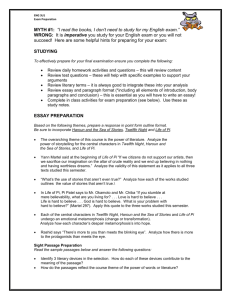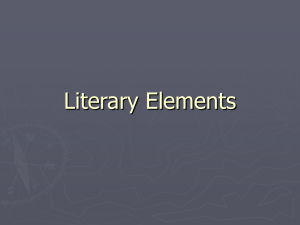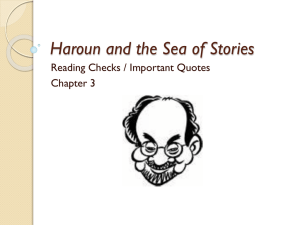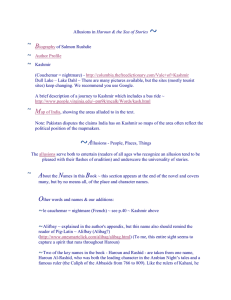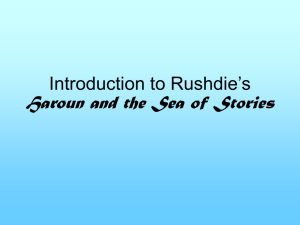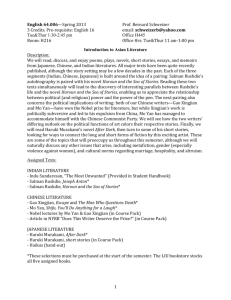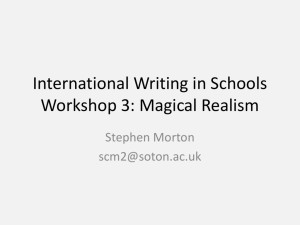Haroun and the Sea of Stories Chapter Questions
advertisement
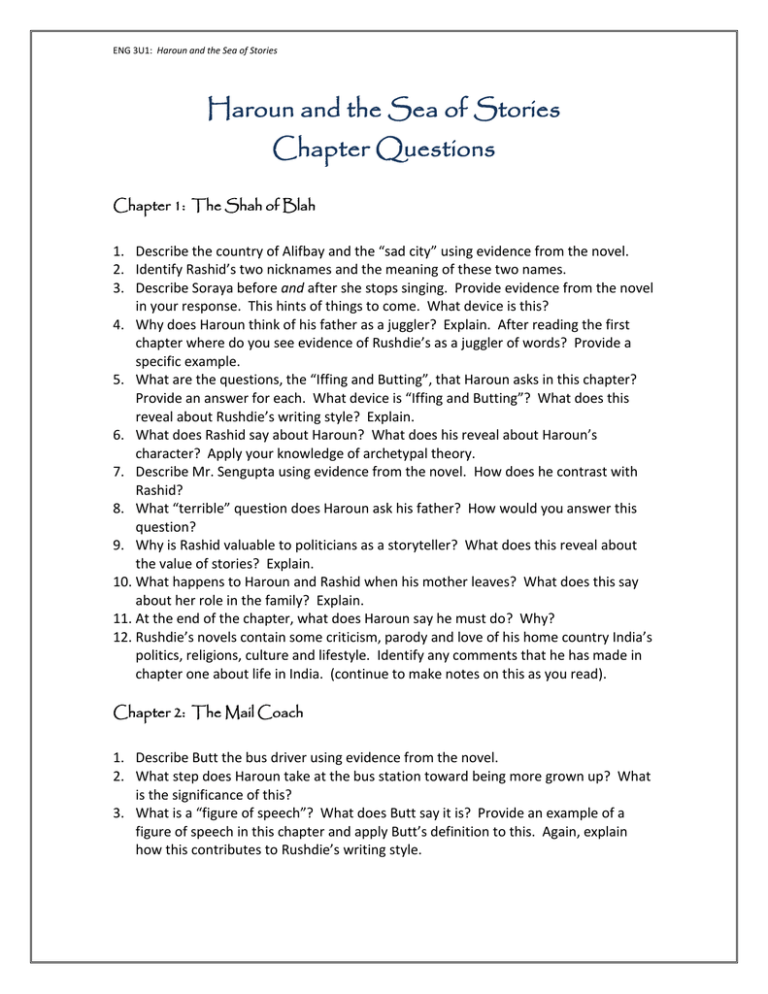
ENG 3U1: Haroun and the Sea of Stories Haroun and the Sea of Stories Chapter Questions Chapter 1: The Shah of Blah 1. Describe the country of Alifbay and the “sad city” using evidence from the novel. 2. Identify Rashid’s two nicknames and the meaning of these two names. 3. Describe Soraya before and after she stops singing. Provide evidence from the novel in your response. This hints of things to come. What device is this? 4. Why does Haroun think of his father as a juggler? Explain. After reading the first chapter where do you see evidence of Rushdie’s as a juggler of words? Provide a specific example. 5. What are the questions, the “Iffing and Butting”, that Haroun asks in this chapter? Provide an answer for each. What device is “Iffing and Butting”? What does this reveal about Rushdie’s writing style? Explain. 6. What does Rashid say about Haroun? What does his reveal about Haroun’s character? Apply your knowledge of archetypal theory. 7. Describe Mr. Sengupta using evidence from the novel. How does he contrast with Rashid? 8. What “terrible” question does Haroun ask his father? How would you answer this question? 9. Why is Rashid valuable to politicians as a storyteller? What does this reveal about the value of stories? Explain. 10. What happens to Haroun and Rashid when his mother leaves? What does this say about her role in the family? Explain. 11. At the end of the chapter, what does Haroun say he must do? Why? 12. Rushdie’s novels contain some criticism, parody and love of his home country India’s politics, religions, culture and lifestyle. Identify any comments that he has made in chapter one about life in India. (continue to make notes on this as you read). Chapter 2: The Mail Coach 1. Describe Butt the bus driver using evidence from the novel. 2. What step does Haroun take at the bus station toward being more grown up? What is the significance of this? 3. What is a “figure of speech”? What does Butt say it is? Provide an example of a figure of speech in this chapter and apply Butt’s definition to this. Again, explain how this contributes to Rushdie’s writing style. ENG 3U1: Haroun and the Sea of Stories 4. What is the explanation provided for places known by letters of the alphabet? Do you see a pattern in the letters? Why would Rushdie replace Indian names with letters? 5. What does Butt mean when he says “Need’s a funny fish: it makes people untruthful”? Provide an example of this from your personal experience. 6. Again, what does Rashid say when he is impressed with something that Haroun does? Why does he say it here and what does this tell the reader about Haroun? 7. What does Khattam-Shud mean? What do we learn about Khattam-Shud? Allegorically, who or what could Khattam-Shud represent? 8. Using evidence from the novel, describe Mr. Buttoo. What does Haroun do to make him angry and what does Haroun fear will happen because of this? Chapter 3: The Dull Lake 1. Research Kashmir and Dall Lake. What do you discover about this region? Make connections to the novel and the author. 2. How does the weather reflect the emotions of the characters? What is this device called? 3. What does Haroun do to change the situation? Explain why is this significant to character development. 4. Explain how the lines between make-believe and reality are becoming blurred. 5. Refer back to page 17. What is the “subscription” Rashid is referring to? 6. Who Iff and why has he come? How is this character archetypal? 7. What important decision does Haroun make in this chapter? How does this conform to Joseph Campbell’s monomyth? (the hero cycle) 8. Identify literary allusions in this chapter. Chapter 4: An Iff and a Butt 1. Why does Haroun go with Iff? Where are they going? 2. Summarize the meaning of Iff’s speech on p.43. What are the most important things he says? What is the author’s message through Iff’s gentle criticism of Haroun? 3. Why does Haroun refuse to return the disconnecting tool? What could it represent? 4. What is Butt the Hoopoe? Describe its unique characteristics. What archetypal character could he represent? Look up the literary symbol of the hoopoe in Eastern literature. 5. What is P2C2E House? What does it stand for? 6. What is wishwater? Why can’t Haroun make use of it? 7. Describe Haroun’s dream story. How is it polluted? Explain based on what you know about archetypal princess rescue stories. 8. What details are provided about the cause of the pollution? 9. Identify at least three literary allusions in this chapter. ENG 3U1: Haroun and the Sea of Stories Chapter 5: About Guppees and Chupwalas 1. At what stage in the monomyth is Haroun? Provide evidence to support this. 2. Explain what Kahani is. For the “disbelievers”, how can it exist unknown to us? What are its characteristics? 3. Who are the Guppees and Chupwalas? Using a “T” chart, contrast the two societies. Using the Glossary at the back of the novel, what do these words mean, and how are these appropriate names for these societies? 4. Who is Mali? Describe his role in society and the novel itself. 5. Who are the Plentimaw fish? What is their role? What is the pun contained in their name? (there are two puns) 6. What is the Old Zone? What does it symbolize on an allegorical level? Explain. 7. What is the metaphor Rushdie uses to create and describe the Gup Army? Again, how does this characterize Rushdie’s style? 8. Identify the two reasons war declared on Chup? 9. Describe Princess Batcheat. What does her name mean? (*see the glossary) How does she conform and defy to traditional female roles in literature? Explain. Chapter 6: The Spy’s Story 1. Who is the spy? What is his punishment and what does this reveal about their society? What did Haroun think it should be and how does Iff react? What political statement could Rushdie be making? 2. Related to this, what is Haroun’s concern about the Guppies going to war? 3. How did Rashid get to Gup? Summarize his (mis)adventure thus far. What does the spy reveal in his story? 4. Who is Blabbermouth? Why is this name appropriate for a Gup? Is her character archetypal? Explain why or why not. 5. What is Bezaban? What does a follower of Bezaban have to do according to the Guppies? 6. Why has Batcheat been kidnapped? How is her character archetypal? 7. Summarize Blabbermouth’s complaints about Batcheat. 8. What is Blabbermouth’s skill and why does she show it to Haroun? What or who does it remind you of, and what is the significance of this? 9. What does she say about women’s role in society? What does it says about Gup and women’s role in modern society 10. Contrast Batcheat and Blabbermouth as characters and explain why Rushdie would include such different female characters. Chapter 7: Into the Twilight Strip 1. Research The Twilight Zone. What was this and why would Rushdie include this allusion in the novel? ENG 3U1: Haroun and the Sea of Stories 2. What is lamination and what does this have to do with the suits they wear when they enter the Twilight Strip? 3. In general, how is the Gup culture, society and way of solving problems characterized in the novel? 4. Explain the wordplay on p.118. Underline key words and phrases. 5. Analyze Iff’s comments “What is the point of giving persons Freedom of Speech if you then say they must not utilize the same?” and “Is not the Power of Speech the greatest Power of all?” Provide examples from current events to illustrate your point. Connect this to Rushdie and his experiences as a writer. 6. What important understanding does Haroun arrive at on p.125? Explain. Chapter 8: Shadow Warrior 1. Who is the Shadow Warrior? What does his name mean and how does he communicate? (see the glossary for the definitions) 2. Why did he escape from Khattam-Shud? 3. What does he reveal about the Khattam-Shud and Chup society? Provide specific reference to the novel. 4. What is Rushdie commenting on through the silence laws? Explain. 5. What is learned about Chupwalas and their shadow-selves? 6. Where are Khattam-Shud and his Shadow? Why and what could this mean for the two societies? Explain. 7. What does Haroun volunteer to do? Why is this an important step for his character? What stage is this in the monomyth? 8. What is wrong with the waters as they proceed to the Old Zone? What does it symbolize and what is Rushdie saying about stories and literature? Explain. 9. What happens at the end of the chapter? What could be the consequences of this? Chapter 9: The Dark Ship 1. Describe the Chupwalas on the dark ship. 2. What is symbolic about their eyes? 3. With specific reference to the novel, describe the dark ship. What is the purpose of the dark ship? 4. What is ironic about Khattam-Shud and his character? Who does he remind you of? 5. Allegorically, who does Khattam-Shud symbolize? Explain why. 6. What happens when Haroun confronts Khattam-Shud? What stage of the monomyth is this? How do you know? 7. What is symbolic about the monster Khattam-Shud becomes? Explain. 8. What does Khattam-Shud say about the dangers of stories? Do you agree with him? Are stories an “Ocean of Trouble”? If not, what are they? 9. What conclusions does Haroun arrive at to his original question “What’s the use of stories that aren’t even true?” ENG 3U1: Haroun and the Sea of Stories Chapter 10: Haroun’s Wish 1. What does Khattam-Shud desire? What statement(s) is Rushdie making through this? Support your response. 2. What does Khattam-Shud shown Haroun on the ship? Why is this significant 3. What doe the Dark Ship symbolize? Explain. 4. How does Haroun escape Khattam-Shud? Who helps him and how is this archetypal? 5. What is Haroun’s wish? Explain why is this so significant to his character development. 6. What stage of the monomyth is this? 7. What happens as a result of this to Khattam-Shud and his shadowy men? The two societies? Chapter 11: Princess Batcheat 1. What is interesting about the Guppee army’s appearance? Where are they planning to fight? What is the meaning of this? 2. What does the Chupwala tell the Gups? 3. How does Blabbermouth save the Gup leaders? Why is this significant? What is Rushdie commenting on through this episode? Explain. 4. Describe the differences between the Gup army and the Chupwala army? Who is the victor and explain why. 5. What happens to Khattam-Shud? How is this ironic? Explain. 6. What rewards are Blabbermouth, Iff, Mali, and Goopy and Bagha 7. How are all the storylines tied up in this chapter? Chapter12: Was it the Walrus? 1. Who sung the song “I Am the Walrus”? Why would this be included in the novel? 2. What does Haroun wish for when he meets with the Walrus? What does this asy about his character. 3. Haroun and Rashid return to the houseboat and very little time has passed. How does this conform to the magic realism genre. 4. What is the name of the sad city? What does it mean? How is this significant to the novel? Explain. 5. What happened to Mr. Sengupta? Mrs. Sengupta? 6. What does Haroun receive upon his return? What does this gift symbolize? 7. What does he find under his pillow? How does this conform with the genre? Explain.
